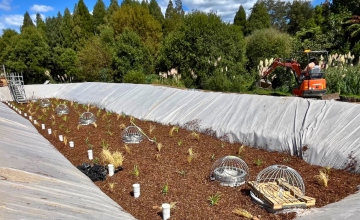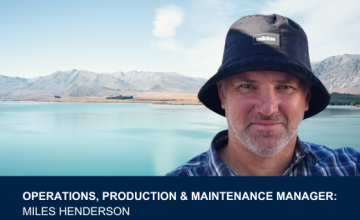Success: Seeing the future in clear water
2 May 2011
Duo faced long struggle before finding a market for stormwater-treatment technology.
As university students, Greg Yeoman and Mike Hannah worked hard and played the same way.
Weekends and holidays usually involved some sort of beach-centred activity: surfing, fishing or scuba diving.
It was that time at the beach that sparked their interest in water quality, and led them to develop a business - Stormwater 360 - that now turns over more than $3 million. Their eco-friendly stormwater filter products are sold in New Zealand and Australia and they have a licensing agreement with a United States company to market a range of filter products which they re-engineer for New Zealand conditions.
Right now they're using an $80,000 Technology New Zealand grant to further develop their original invention, a roadside stormwater filter called the EnviroPod - or the "tea strainer" - that filters out rubbish and other contaminants.
Making money from the environment is a double-edged sword, says Hannah.
"People don't trust you for some reason. People say they care about the environment but when it comes to spending money, they don't."
After graduating from the University of Auckland, Hannah, who'd studied engineering, designed eco-friendly water treatment systems such as wetlands and ponds. While hanging out at the beach he and Yeoman had noticed the amount of rubbish floating in the sea; at the time, he says, people believed it came from boats. However, through his job Hannah saw that invisible nasties such as dissolved metals from vehicle brake and clutch linings, and insecticides, were also making their way into the ocean.
"We saw that everything on the road ended up in the harbour," he says. "That scared us, and we figured that there must be something we could do to help fix that problem."
Still working full time, Yeoman, an architect, and Hannah came up with the EnviroPod: a large vacuum cleaner bag placed in a roadside stormwater pit. The idea was simple and had not been done before.
The pair, with mate Brendan Poole, experimented with different fabrics and in 1995 quit their jobs to work full time on designing and testing prototypes. With no income for the first few years, they rotated their time in the business in a unique style of job-sharing. One would travel around Southeast Asia doing odd jobs for six months, which was cheaper than living in New Zealand, while the other two worked on the business, paid rent on a flat and used the shared car.
Funding from family and the odd bank loan helped keep them afloat.
They patented the product in 1996 and targeted local councils, installing them free on several sites around Auckland's North Shore and inviting local councillors to see what had been collected. However, says Yeoman, the response was tepid.
"There was no legislation to say councils had to use them for stormwater filtering, so we had a product that no one would buy off their own bat."
However, with such low overheads, they managed to get by until the then-North Shore City Council agreed to install 300 EnviroPods. Another break came when they won a $100,000 contract from the Brisbane City Council, which eventually saw 1000 EnviroPods used across the city.
After that success, Poole and Hannah set up shop in Sydney, leaving Yeoman running the New Zealand office.
After researching the market, Poole and Hannah set up a show-and-tell meeting with Jim Lenhart, a US-based stormwater entrepreneur. Lenhart so liked the EnviroPod that he introduced them to steel-treating giant Industrial Galvanisers (IG), which had the licence to sell his own filtering product, the StormFilter. The two products worked together well, so the two companies formed a joint venture, and IG ended up buying 53 per cent of the Kiwi firm.
While that opened doors to new business and boosted credibility, "being in bed" with a large corporate was a struggle, says Hannah, and the two companies were often at odds over their approach to sales. "They drove us hard. We wanted to do more research, they just wanted to get in and sell it."
Despite the rocky road, the relationship lasted five years, until Stormwater 360 bought back its share. The Australian office is now run as a separate company selling the EnviroPod and another product, Lenhart's StormFilter.
Profits from the EnviroPod go back to the New Zealand company. Now, 15,000 EnviroPods are installed in Australia and New Zealand.
Because the stormwater management and treatment industry is only 30-40 years' old, research is a huge part of the business.
The company spends about 10 per cent of turnover on R&D - a fair whack for a small company that employs just eight people. The company also relies on shared information from government-funded researcher Landcare Research and the University of Auckland to further develop some products.
The industry trend now is to "mimic nature", Hannah says, and his company has expanded its product range to include importing eco-friendly filter systems from the US which it customises to suit New Zealand conditions.
One product is the UrbanGreen BioFilter, an underground filter system based on an idea from a US company that uses either trees or other plants and a special soil mixture to filter fine sediments, metals, and other pollutants found in stormwater.
The Stormfilter are used in Christchurch's Pegasus township, Auckland's Sylvia Park mall, along the Tauranga Harbour Bridge and on part of Auckland's motorway system.
Hannah and Yeoman are developing another product for the New Zealand market, a planted filter system called "green roofs", from US company Live Roof. Stormwater 360 imports the specially designed plant trays and works with a local nursery to engineer a soil mix and select plants that will suit New Zealand conditions.
Original article can be found here: http://www.nzherald.co.nz/business/news/article.cfm?c_id=3&objectid=10728343

